
LOST BREEDS - PEKE-FACED CAT
PEKE-FACED CATS
In his "Book of Cats" (1867), C H Ross wrote of a litter of Peke-faced kittens which he attributed to maternal impression (a prevailing theory of the time): "I once had in my possession a very life-like picture of a remarkably ugly bulldog, which hung in a frame over a piano in the drawing-room. With some surprise I noticed that a favourite cat would climb upon the piano and sitting close under the picture fix its eyes on the dog's face, and putting back its ears, remain thus with a wild and terrified expression for as long as an hour at a time. [...] During the time that we noted this conduct on the cat's part, she was with kitten, and when the four kittens were born they were dead, and one of them, strange to say, had a bulldog shaped head, marked almost exactly like the picture."This was described by H C Brooke in 1926: "The 'Peke-faced cat,' which some of our breeders produce now and then, is not confined to this country. My friend Herr Joe Lesti of Vienna recently obtained a short-haired kitten, with protruding underjaw, nose pushed well back, bandy forelegs and slight cowhocked hind legs. He thinks, as do I, that this is a ricketty formation and nothing else, but said of his specimen that did none not know such a cross to be impossible, one might imagine the presence of Bulldog blood." Brooke suggested that one of the Peke-faced cats would only develop drooping ears then the mystery of the Chinese Lop would be solved!
This type is no longer represented on the show-bench although the flat-faced ultra-typed Persians and Exotics are coming close.
PEKE-FACED PERSIAN

Peke-face Persians (solid red and red tabby) generally conformed to the red Persian standard. However, they had slightly higher ears and a very different head due to the skull structure differing greatly from the standard Persian. The bone structure created a very round head with a very strong chin. Eyes were large, round and very wide-set. The nose was depressed and indented between the eyes. The muzzle was wrinkled and there was a horizontal break located between the usual nose break and the top dome of the head. This second break created half-moon boning above the eyes and an additional horizontal indentation in the centre of the forehead. The Standard for the Peke-Face called for a brow ridge, dimple, and a double dome. The term peke-face is often incorrectly used to describe extreme-typed Persians, some of which are certainly flat-faced, but do not have the forehead indentation or brow ridge of the true Peke-face Persian. Peke-face reds appeared in litters of normal reds, but mating two Peke-face Persians together was not guarantee of getting Peke-face kittens in the resultant litter.
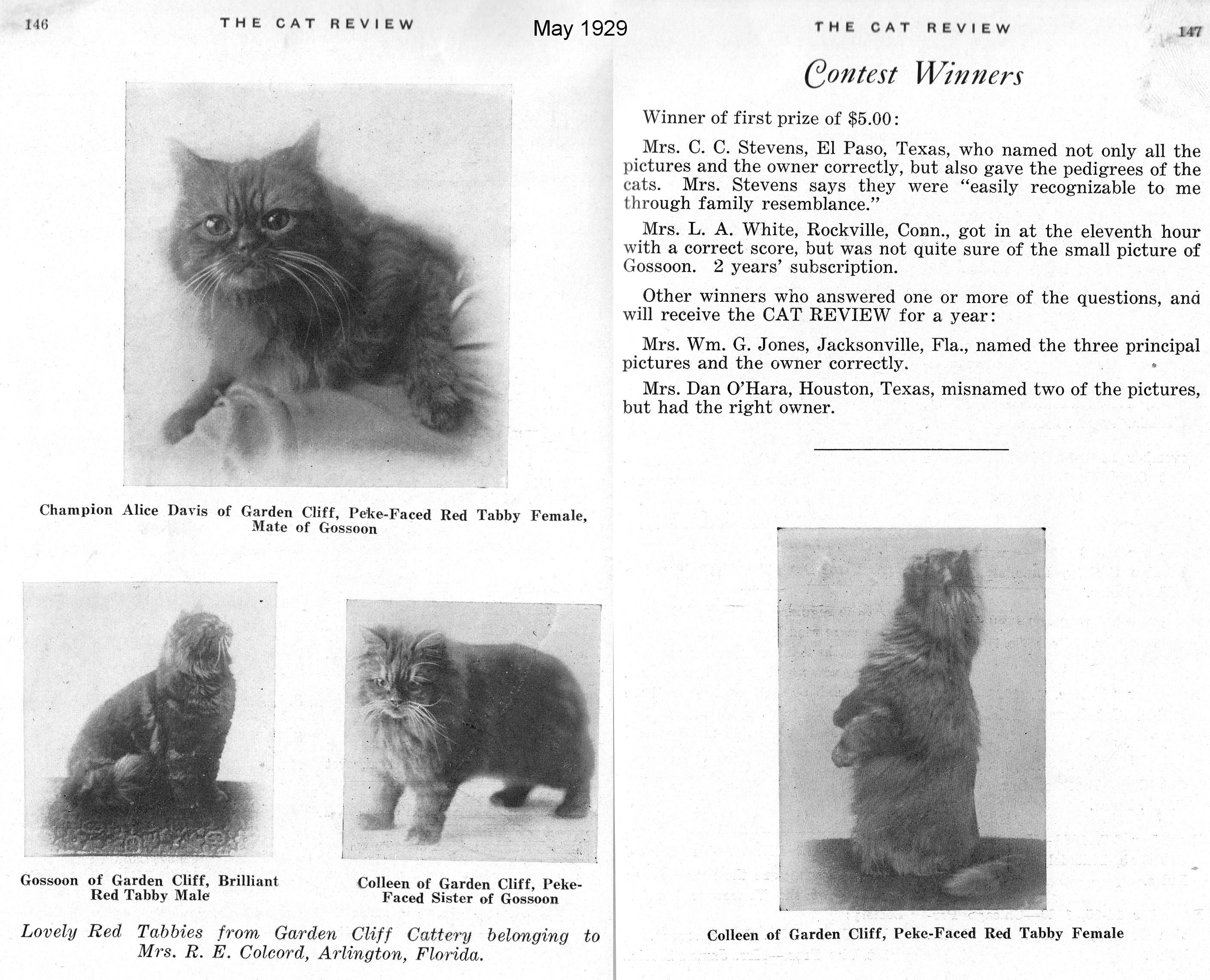
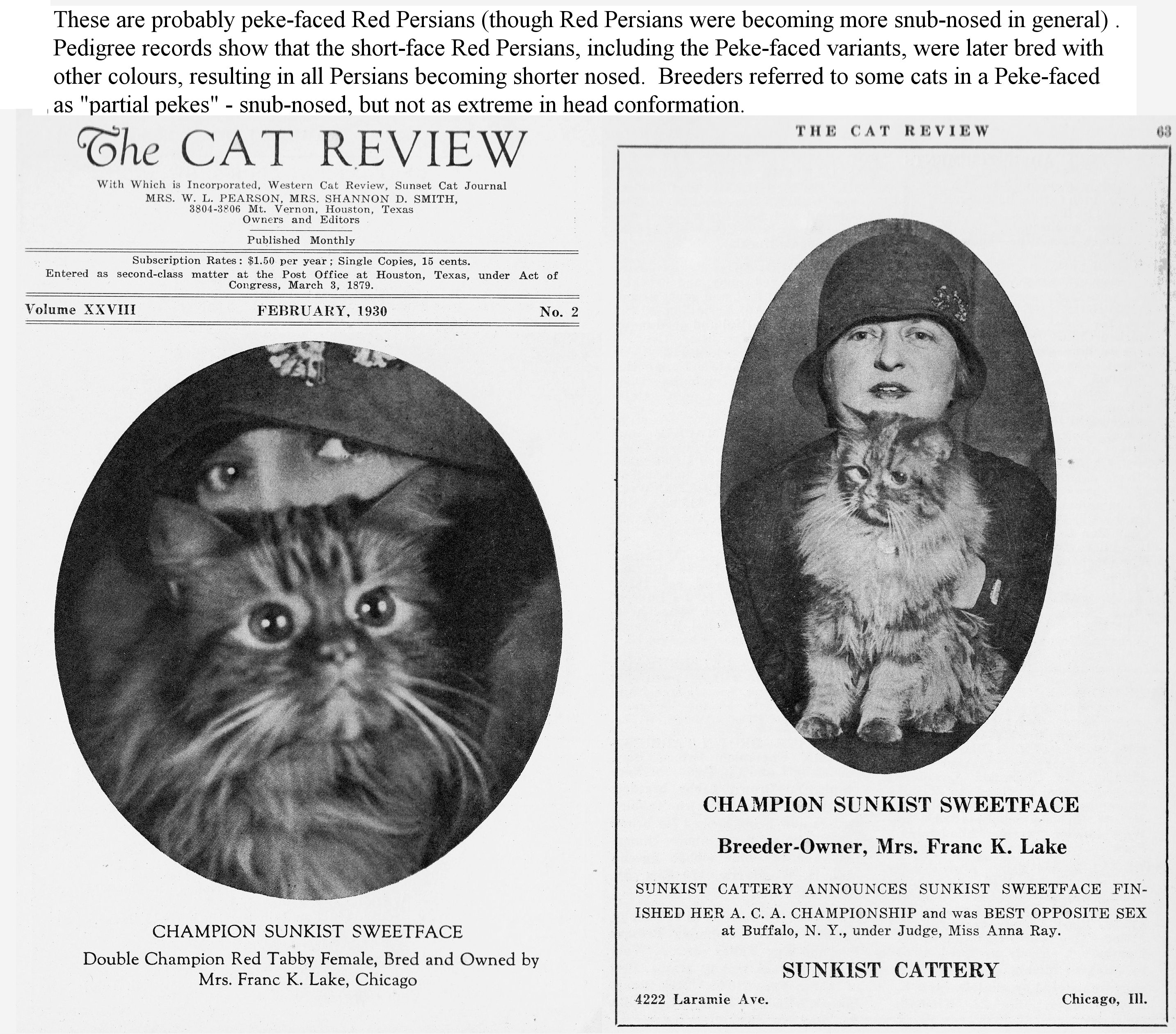
According the the CFA, true Peke-face red Persians are not seen in exhibition today and few CFA judges can remember handling one. Only one (a male) was registered with the CFA in 1993 and a total of only 98 had been registered since 1958. In November 2003. the CFA's Persian Breed Council discussed eliminating the Peke-Face red and red tabby Persian. Only one such cat was registered as a Peke-face in 2002 and there were only 3 Peke-face Persians registered in 2000 and 2001. It was not even certain that those cats were genuine Peke-faced Persians or were extreme-type Persians erroneously registered as Peke-faces. No CFA breeder was known to be working with Peke-face Persians. It is unlikely that any genuine Peke-face Persians survive in 2010.

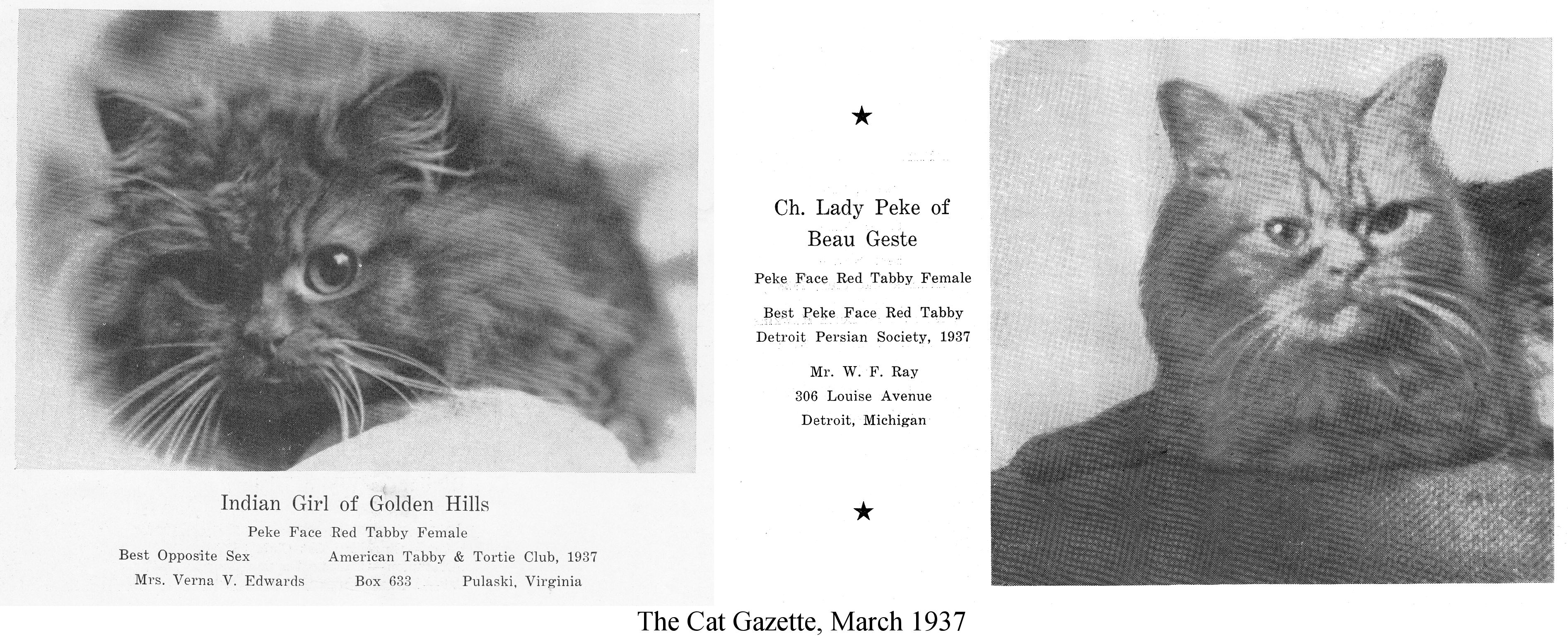
However, the Peke-face may have left its legacy in the increasingly brachycephalic modern Persians in the USA. During the mid 1970s and early 1980s, American Persians changed dramatically. The pre-1980s look had heavy brows, flat-topped heads rather than domed heads. During this period, the "sweet, open-expression" was lost as fanciers pursued an extreme head type (ultra-type). These Persians were dubbed "pigs" or described as having a "piggy expression." The nose became narrow and ultra-high; the breaks above the eyes were moving towards the forehead; the eyes were tiny and the jaws often misaligned to produce a frowning mouth. Tracing pedigrees shows that Peke-Face red Persians were bred to other solid colour Persians, to brown tabbies and to silvers, to produce this piggy look. The teardrop-shaped eye of modern ultras is attribited to the legacy of Peke-face cats. The new look was deemed an exciting development and open-ended standards favoured this look on the showbench. During the 1990s, both open-face and Persian pigs were advertised, but the trend later moved back towards the healthier open-face cats. Besides which, the piggy Persians were just plain ugly.
While "peke-faced" cats are no longer described as such, the words of the Persian/Himalayan and Exotic Shorthair standards may soon need to state the upper edge of the nose leather must be below the lower edge of the eyes.
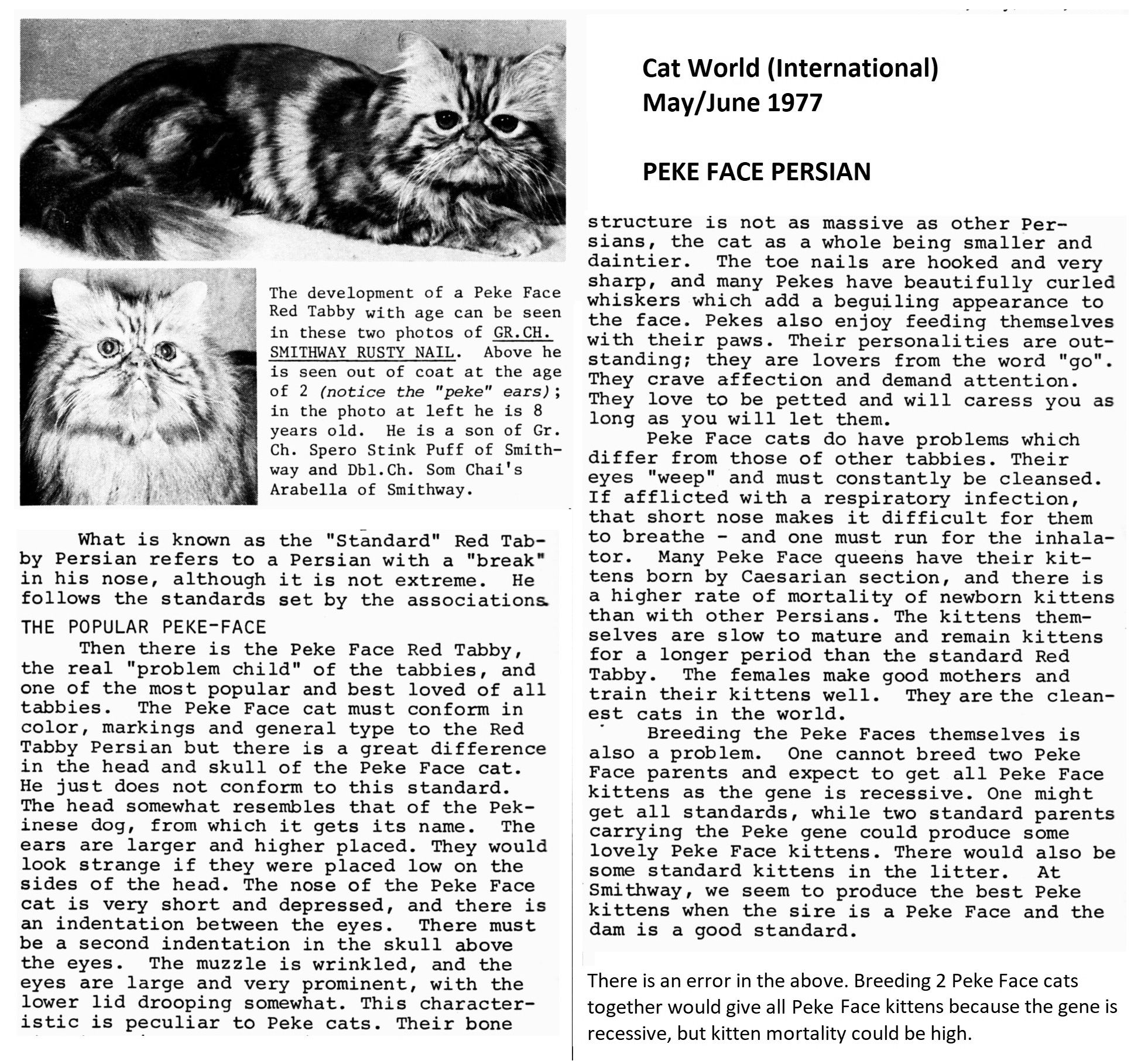
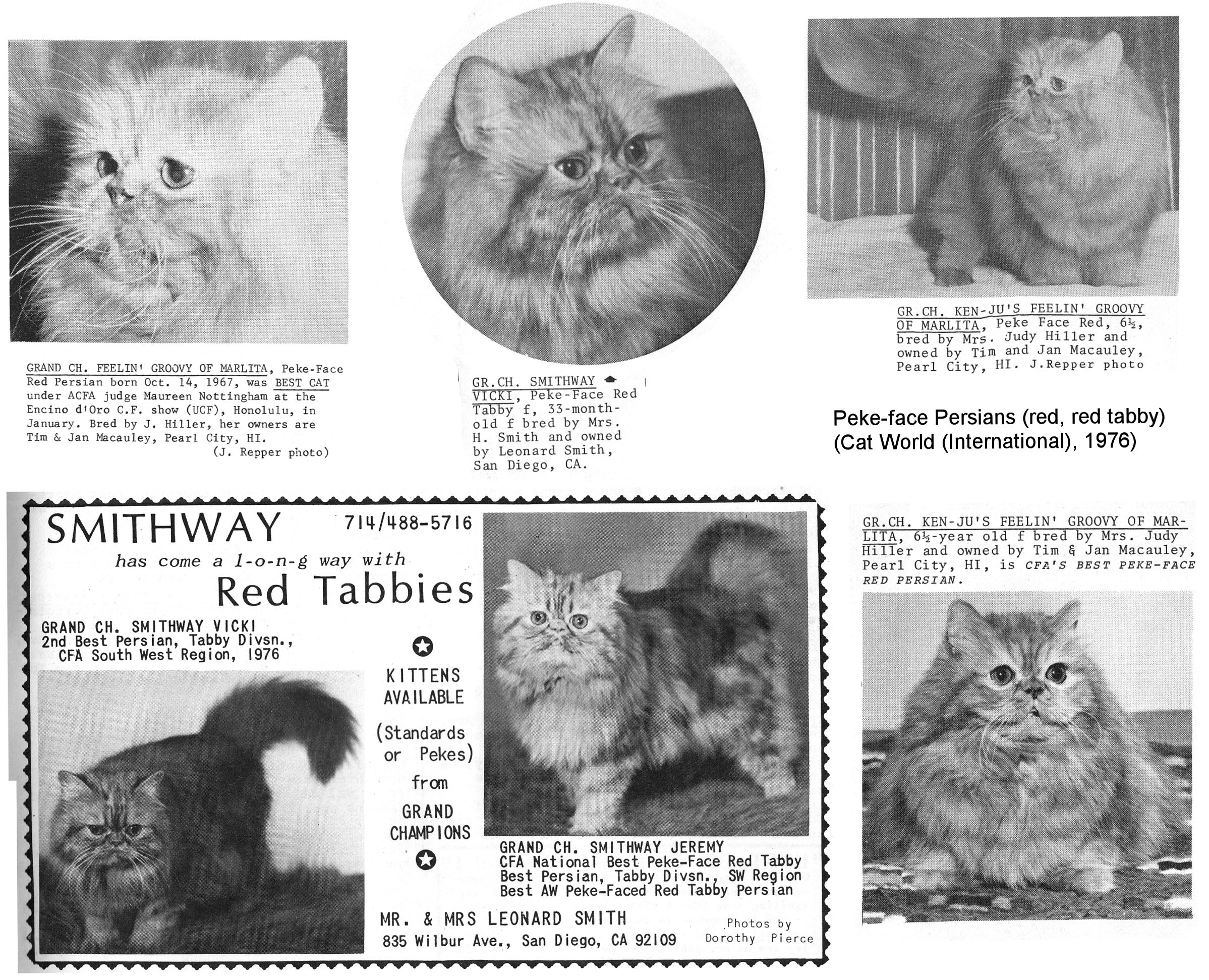
RAJAH MACK AND THE "RAJAH MACK STRAIN"
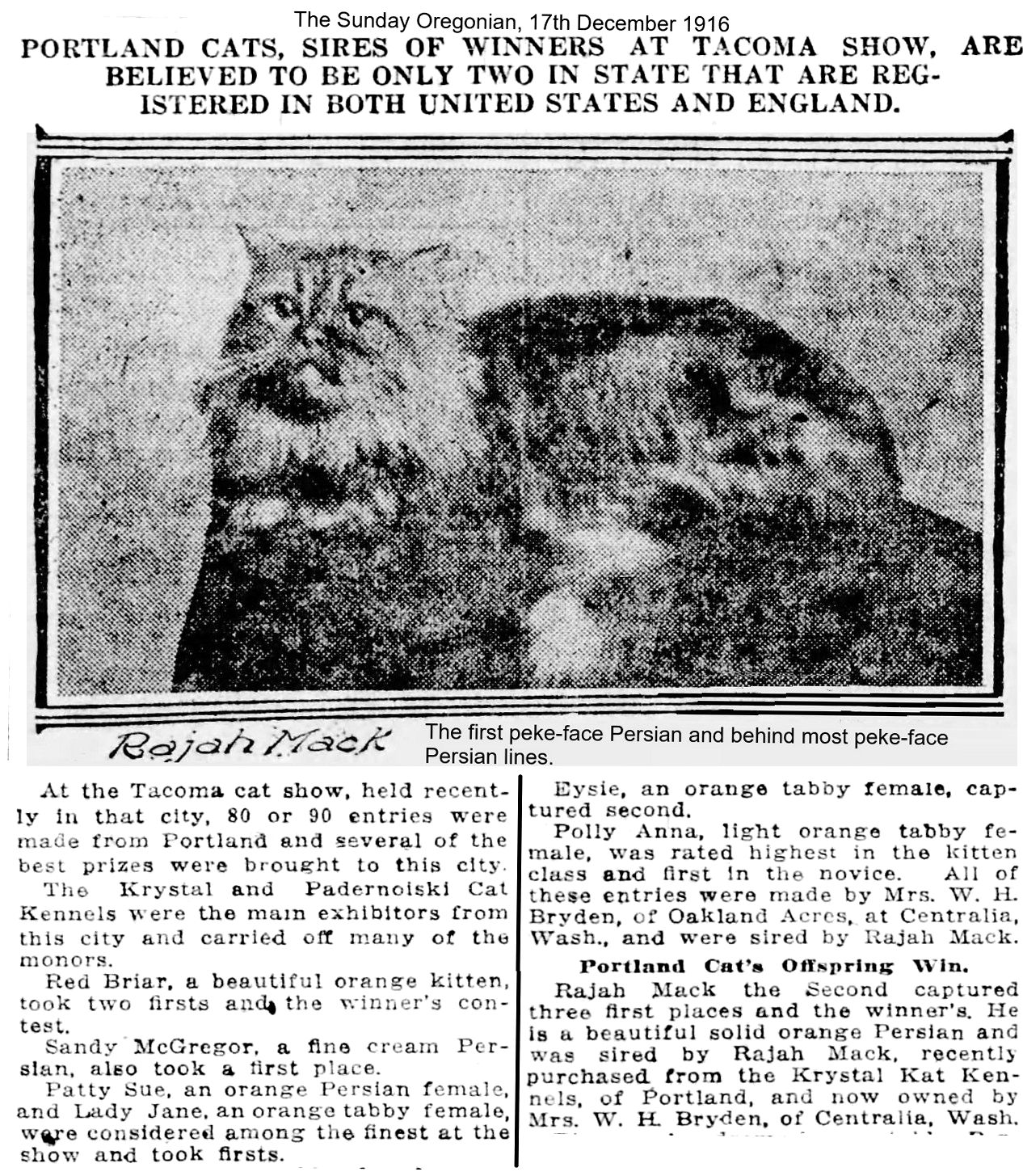
Rajah Mack, born 1st September 1912, is credited by many as the first peke-faced red Persian. Not all peke-face lines trace back to Rajah Mack, but he was so influential in terms of head conformation that cat fanciers referred to "the Rajah Mack strain." He appears multiple times in some pedigrees as sire, grand-sire and great-sire. It's unlikely that he had a single mutation for head-shape as breeders referred to getting "partial-pekes" in litters when two peke-face Persians were bred together, rather he carried a combination of genes/mutations that were passed on to offspring and were fixed by inbreeding. In later generations, selective breeding produced some very extreme cats and this led to the collapse of the Peke-Face Persian as a distinct variety.
Breeders advertised their studs as "of the Rajah Mack strain" or "sired by a son of Rajah Mack" and producing kittens with strong heads. "Oregon Mars," advertised as Rajah Mack strain, was only indirectly related to Rajah Mack via (Brushwood) Red Ruff several generations earlier. This shows that Rajah Mack's head conformation was highly sought after.
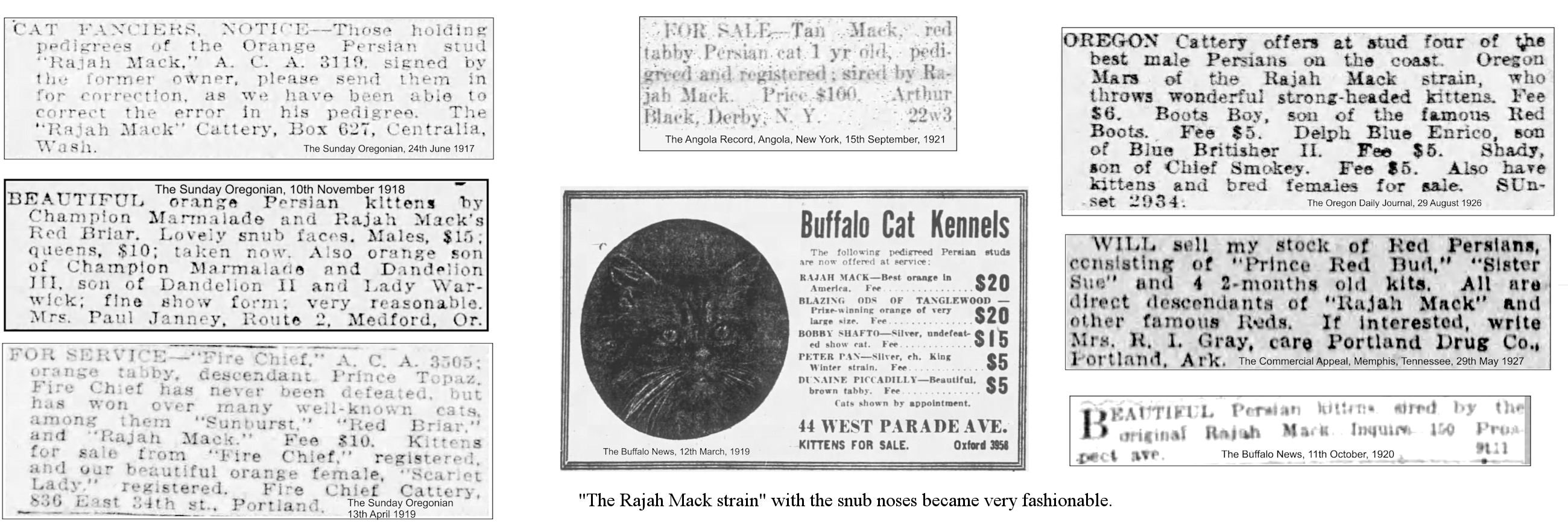

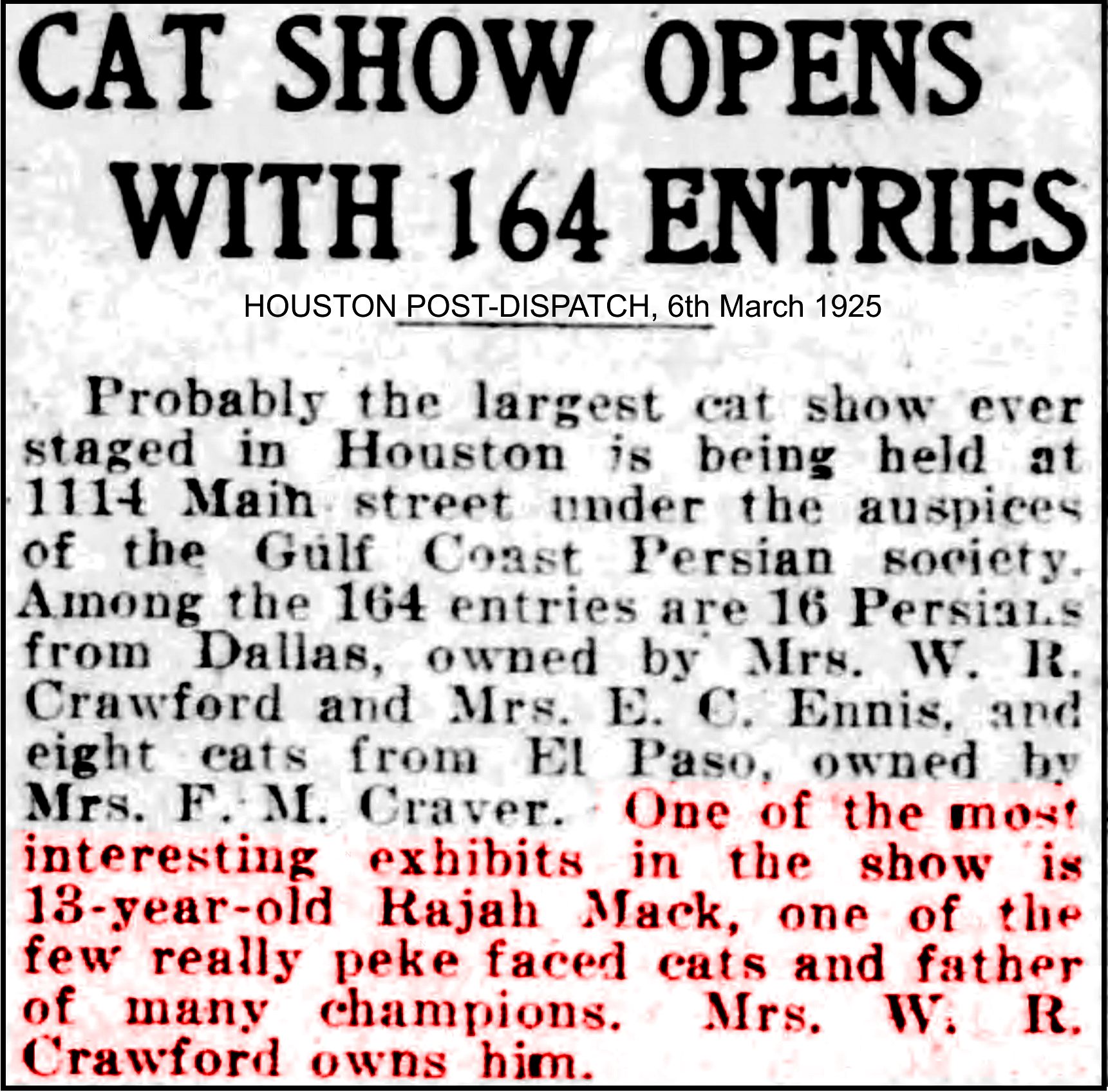
THE PEKE-FACED PERSIAN TIMELINE
These excerpts, including show results, name some of the peke-face Persians and their breeders.
The Vancouver Sun, 22nd August 1917, reporting on the Canada Pacific Exhibition, wrote "The best male is Rajah Mack's Red Briar, owned by Mrs. W. H. Bryden of Centralia, Wash. He is a solid orange of gorgeous type and colour with a bulldog head."
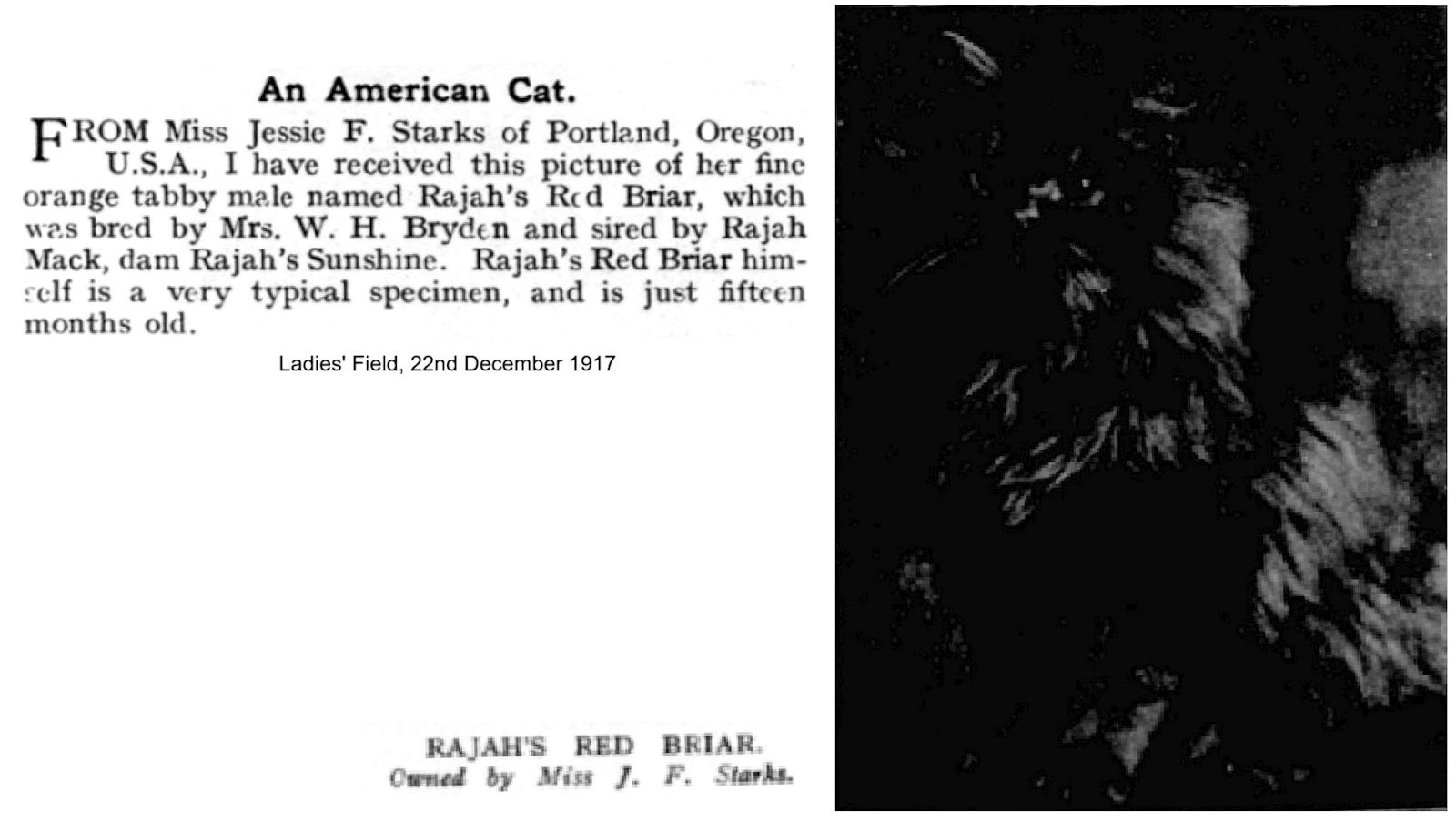
WONDER WHAT 'WONDER' HASN'T WON? By Jane Elwyn, The San Francisco Examiner, 28th November, 1926
"He stood, a reddish crescent,
Flouting the ivory moon,
Then raised the pibroch of his race,
The Song without a Tune."
Tasso.
He's a "Peke-Face." If you know what that means. When he was a tiny baby, this reddish flame, roamed the wilds of Washington on an immense ranch, together with his mammy and his daddy who were both from a long line of 'Peke-faces." A silky haired Persian, he eventually reached this city and was purchased by Mrs. Belle Dufau Brooks, who realized what a wonderful kitten he was. That was in 1923. Mrs. Brooks began the kitten's education at once and showed him In the same year at the Pacific Cat club's show, and under Mrs. Jack Gordon, this lovely red tabby cat won in the open class and wound up by taking a winner's ribbon. Pretty good for the first time out.
In 1924, Champion Sunset Wonder again showed what he could do by repeating these wins, this time under Mrs. de Castro, of this city. At the Oakland fixture he went winner in the orange tabby class and best male in the orange division. This was under the English judge, Mrs. Jack Gordon. At the Pacific Cat club show in 1925, the Wonder won at the Civic Auditorium. taking first and winner in orange tabby class and best male in orange division. Also winner of the Pacific Cat Club Challenge Cup, known as the "Samoa Trophy." In fact, the Wonder has won every time he has been shown, and in a remarkably short time won his Championship outright.
This handsome pure-bred Persian is the grandson of the great "Rajah Mack," a splendid red tabby shown at the St. Francis Hotel several years ago, and a big winner. Mack lives in Texas at present, is fifteen years old and still siring "Peke faces." The sire of Wonder is Chum-Chum and his dam "Peke-Face" sister. He comes from a long line of red tabbies with a most peculiar nose formation.
His head is remarkably broad and flat, with a square muzzle; not a hair of white on him, which means he is sound in color, a very important point in an orange cat. The term "Peke face" has been used in describing his ancestors for many generations, for they excel in having smashed-in faces, their noses set into the face just exactly like that of a highly-bred Pekingese dog. The nose, though absolutely natural, has the appearance of being broken at the stop, so very abrupt is the drop. But this champion disproves any statement of that kind, for all of his kittens have that most desirable point.
Wonder has one of the grandest heads ever seen on a Persian and when in full bloom he is a hard one to beat, for he can go in and win against all comers. He weighs eighteen pounds, is lovely In color, massive boned. Topping the rest of his show points, his face is set off by great copper, saucer-shaped eyes, in which a slumbering devil lurks. His coat is red, glossy and full of life, with deeper stripes and bars, giving a two-toned effect of burnished copper. Between his eyes he has a perfect "M," which stands for "marking." A long, dark line extending from his eyes gives him a Theda Bara expression. Three spinal stripes extend to his ringed tail.
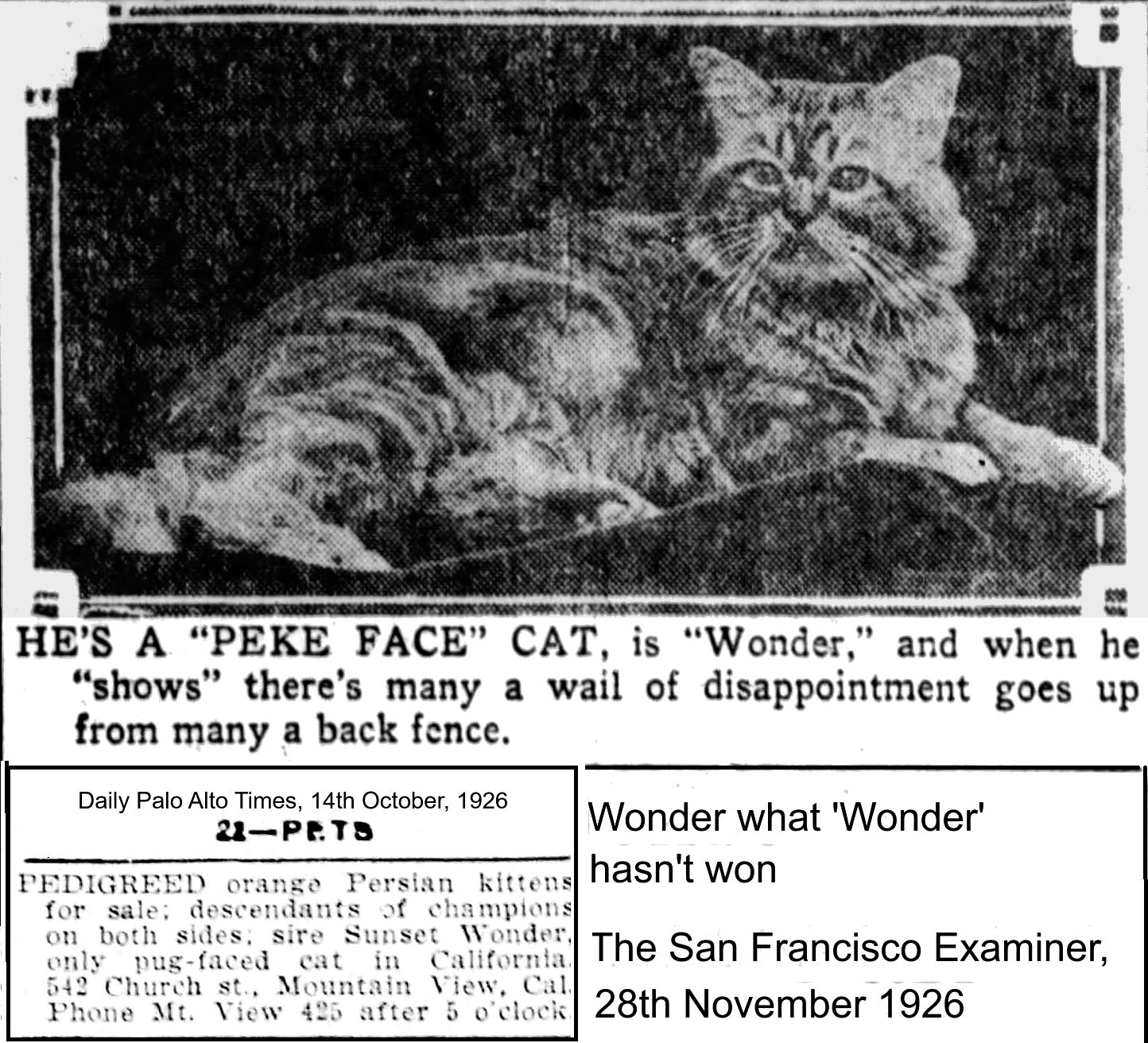
Tornado of the Fox Valley is the name of another male in the Stevens's cattery [Mrs C.C. Stevens, Dreamerie Cattery] who has an important page in the American-Persian furry nobility. He is the sire of Geisha Girl, cowinner of the Palmer cup. Her mother was Missy, from a "peke" face strain. Geisha's sister is Champion Dreamerie Flame, now owned in Hamilton, Canada, also bred in the Stevens's cattery. The sire of Princess Aristocrat was Champion Carmine Aristocrat, her dam Ming Champion Ming Princess Loraine II, "peke" faced. (Big Persian Cats Win Many Honors. More Glory For El Paso Owner. El Paso Herald, 10th October, 1925)
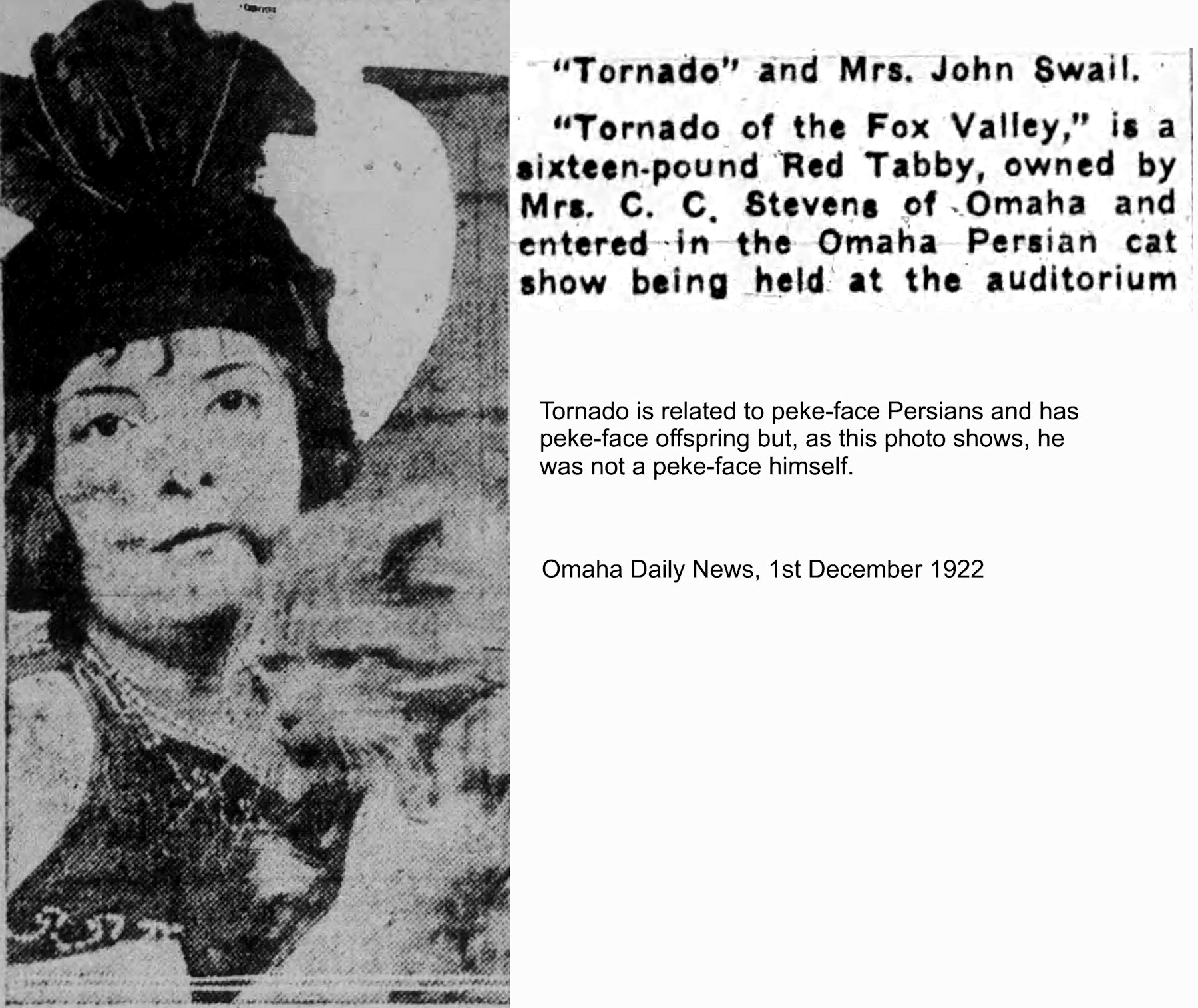
The Dreamerie cattery, owned by Mrs. C.C. Stevens, will have on display four generations of red tabbies bred in the Dreamerie cattery as well as several "peke" faced cats, so called because o their snubby faces, resembling the face of the Pekingese dog. These "pekes" are much in demand by eastern cat fanciers. (Blooded and Domestic Cats Vie for Honors. El Paso Times, 13th February, 1928)
The Portland Cat Show will be held December 4, 5 and 6 at the Auditorium . . . Two prize cats already entered are Prince Omar, a Smoke Persian owned by Mrs. Dorothy Doyle Lucas, and Flame, owned by Mrs. Edna Tingley. Flame is a massive Peke-faced orange tabby. (The Oregon Daily Journal, 16th November 1930)
[. . .] |First annual cat show of the Tulsa State Fair to be held three days of fair week, September 20, 21 and 22 . . . Best red tabby Peke-faced kitten (must have good eye color), Mrs. Ray Henry offers the Midwest Cattery Cup. (The Record-Democrat, 17th September 1931)
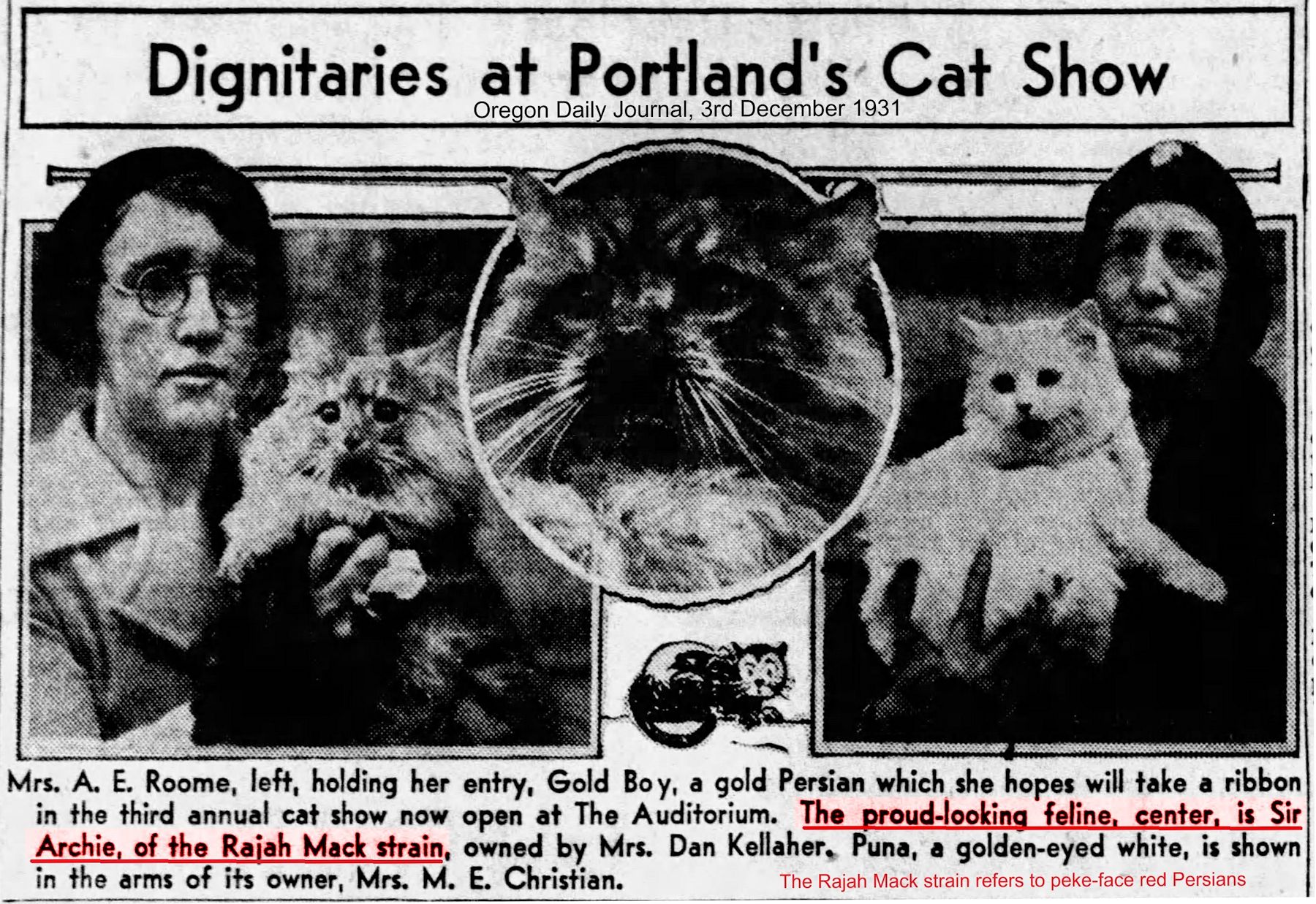
The Sedalia Persian Society Cat Show, November 1933:
Red Tabby female peke-face open, 1st Oak Hall Farm, on Lady Patricia of Oak Hall.
Red Tabby female peke-face novice, 1st Mrs. Helen M. Ware, on Thistledown Bright Flash; 2nd, Mrs. T.R. Carrell on Coppermaid of Goldkette.
Red tabby male senior peke-face kitten, 1st, Ovid Son o'Felix.
Red male peke-face novice, 1st, Mrs. R.B. Davis, on High Tone Boy.
Red male peke-face junior kitten, 1st, Oak Hall Farm, on Red Snapper of Oak Hall.
ABOUT OUR CATS - PEKE-FACED RED PERSIAN. Peke-faced Reds are a new development in the, Persian cat fancy; a variety produced, it may be, by a violent. effort to breed out the Red's tendency to have a long, narrow nose. The newly founded stud book of the United Cat Clubs of America classifies Peke-faced Reds in its standard of perfection, and recognises it as a distinct variety in championship shows. The American Cat Association and the Cat Fanciers' Association have not yet so recognized Peke-faced Reds. The Peke-faced Red, as the name indicates, has jaw structure like a Pekinese dog's. Nose is "shoved" back into the skull, producing in addition to the characteristic jaw structure, the characteristic Pekinese scowl. The Peke-faced Red's head should be very round, with very large, round, wide-open eyes. The nose should be extremely short and wrinkled, with a trace of the wrinkle extending under each eye. The jaws should be even, the ears round tipped. small, and set wide apart. Neck should be short and eyes deep orange of brilliant copper. (The Cleveland Press, 27 November 1933)
"Country Gentleman," owned by Mrs. W. E. Johnston of Minneapolis was awarded the cup for the best peke-faced cat in the exhibit. (The Duluth News Tribune, 27 November 1934)
Best Red Tabby peke-face, Viking Marihuana, Mrs. Harry Beard.
Red tabby peke faced male open; first and winner, Viking Gene Toy, Mrs. Harry Beard.
Red tabby peke faced female novice; first, Viking Copper Jean, Mrs. Harry Beard.
Red tabby peke faced female open; first and winner, Viking Marihuana, Mrs. Harry Beard.
(Persian Society Cat Show Closes; Final Judging Results Announced. El Paso Times, 7th January 1935)
With judging in the sixth annual championship cat show of the Miami Valley Persian Society . . .
Red Dawn's Mr Cherry Ladd of Castlewood, best peke-faced red male, owned by Mrs. Bundrock.
(Award Honors to Best Cats in Show Here, Dayton Daily News, 13th January 1935)
The fourth annual championship cat show sponsored by the Minneapolis Persian Cat Club . . .
"Sunkist Boop-a-Doop Queen," a peke-faced red tabby, entered by Mrs. Franc K. Lake, Chicago, was judged best female in its class, with "Red Sugar Bear" owned by Mrs. L.P. Schroeder, Minneapolis, winning first for males.
(Awards go to Winners at Cat Show, Minneapolis Tribune, 9th December 1935)
El Paso Cat Council Show, November 1936
Best Peke-face cat, "General Yen." Peke face red tabby male open class, owned by Mrs. O. Ballard, 3911 Oxford Street, and best Peke face opposite sex, "Lovely Lady," Peke face red tabby female novice class, owned by Mrs. R. C. McGregor, 2817 Nashville Street.

8th annual cat show that ended at 10 p.m. at the Multnomah Hotel . . .
Best peke-faced orange, Little Wendy's Princess Gilmore, Mrs. Pearl Allison.
Best peke-faced red tabby, Banjo, Miss Louise Douglas.
Peke-face red - Class 60, female open: First Little Wendy's Princess Gilmore, Mrs. Allison; Class 68, male open: First, Neno Boy, Mrs. Meehoff; second, Prince Mouser, Mrs. Eva Meehoff. Class 73, male senior kitten: First, Sonny Boy, Mrs. Meehoff; second, Puff, Jennie I. Clark. Class 77, neuter and spay; First, Noneen, Mrs. Geoge Tascherau.
Peke-face red tabby, male, open: 1, Sonny Boy, Mrs. Binger Sefton; 2, Viking Major Jack [possibly = Viking Major Mack], Mrs. A.T. Hahn. Male novice: 1, Banjo, Miss Louise Douglas. Female, open: 1, Goldie Splendor, Mrs. L.C. Pershin; 2, Lady Minnie, Mrs. Pershin; 3, Fairwood's Amberette, Mrs. McCleary. Male junior kitten: 1, Sparky Mack, Ninger Sefton. Female senior kitten: 1, Ming Toy, Mrs. Pershin.
(Cups Awarded to Feline Blue Bloods, The Oregon Sunday Journal, 20th December 1936)
Between 50 and 60 different breeds of cats will be exhibited at the annual cat show of the Heart of America Cat Society, Inc., which will start Friday at Drexel hall, 3301 Baltimore avenue. Mrs. Jess Adair, secretary of the society, has announced there will be a greater number of entries than ever before. Peke-faced cats, so called because they resemble the Pekingese dog, will be entered in the show for the first time in several years, Mrs. Adair said. (Kansas City Journal, 13 January 1937)
The Springfield News-Leader (Missouri), February 1937 reported on the Cat Fanciers' association annual show where Mrs. W.P. Baer's peke-faced red tabby Ovid Morning Shadow was awarded a first prize. Following the show, he was painted by the artist Violet Schoenberg-Bolt.
The Vancouver Sun, 3rd September 1937 reported the results of the cat show:
Best in Show kitten opp. Sex - Vancouver Ming Luie (red tabby peke-face), Mrs. Edw. S. Chambers.
Best in Show L.H. junior kitten - Thomas Moore (red tabby peke-face), Mrs. M. Pershin.
Red Tabby Peke-Face - Female kitten - 1 and best, Vancouver Ming Luie, Mrs. Edw. S. Chambers.
Long-Haired Juniors: Red Tabby Peke-Face Male - 1st, Thomas Moore, May Meighan Pershin; 2nd, Vancouver Henry Gratton, Mrs. Edw. S. Chambers.
Two of the heaviest cats in the show are "Sammy," a huge black neuter, who weighs about 20 pounds, and "Jinxy Boy," a 20-pound Persian. Visitors are taking a second look, just to make sure they're seeing correct, when they peer through the wires at the Orange Peke-faced cats. These entries, from Portland, have faces that strongly resemble Pekingese dogs. (The Vancouver Sun, 31 August 1938)
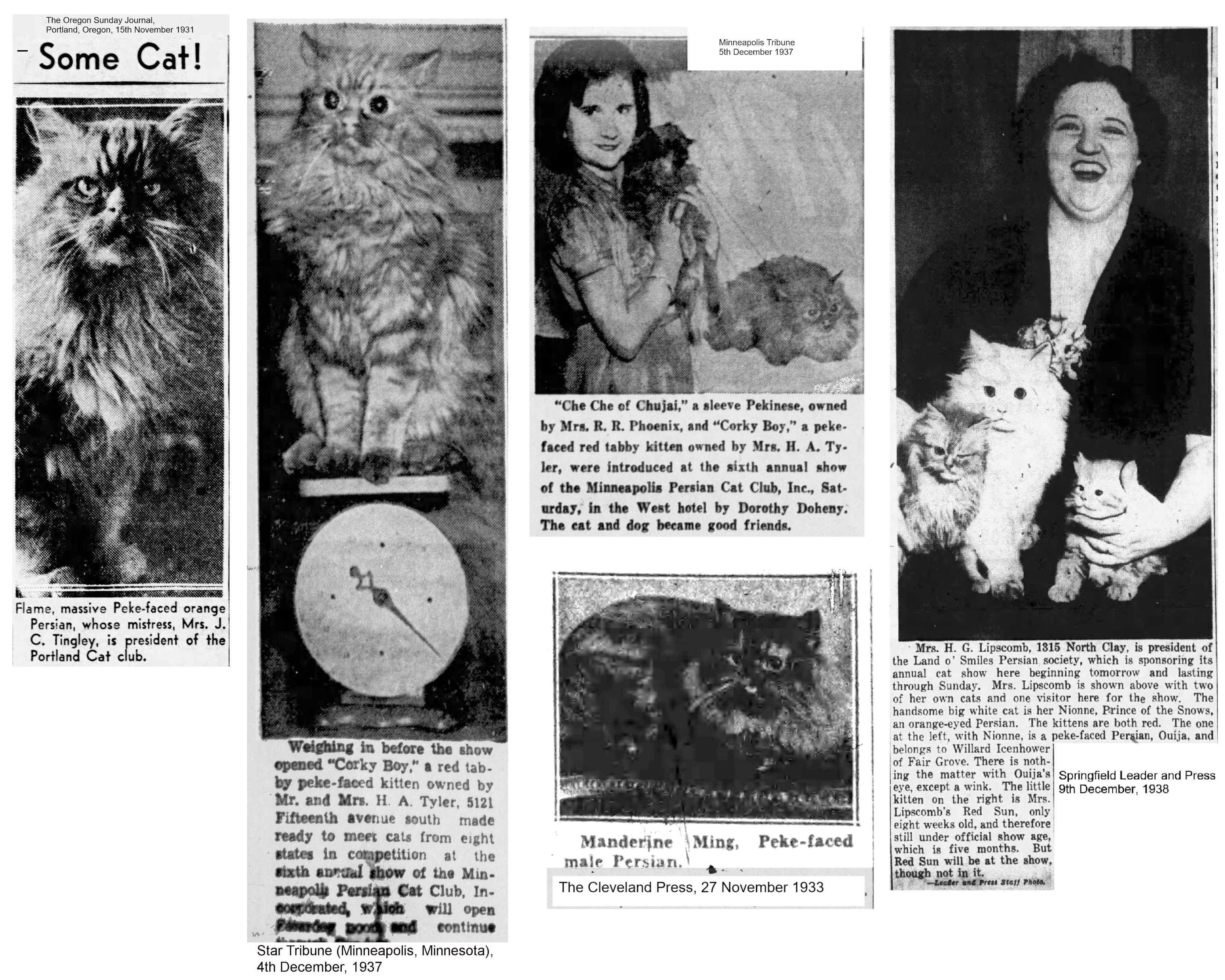
Mrs. R. C. McGregor, president of the El Paso Cat Council, has entered six cats in the fifth annual cat show of El Paso Cat Council and Cat Fanciers' Association, which will be held Friday and Saturday, Jan. 28 and 29, at Community Center. "Beautiful Lady" is her famous Peke faced female, which has won in every show in which she has been entered. Peke cats get their names from their striking similarity to Peke dogs. "Bobby Lou," daughter of '"Beautiful Lady," is a rare cream colored Peke face, and "Piccolo Pete" is a red tabby. These three cats are descendants of "Roger Mack,"[Rajah Mack?] original Peke faced cat of America. The other three cats to be shown by Mrs. McGregor are "Dolly Maguire''' and "Ming Chow," tabbies, and "Little Brother," a Peke face. (El Paso Times, 26 Jan 1939)
"General Yen," yellow cat, has the face of a Pekingese. However, Mrs. C.C. Strange, in charge of the show, says he is supposed to look that way. He is a new breed of cat, with the short pushed face of a Pekingese. He is a peke faced red tabby. (Annual Show is Cat's Meow, El Paso Herald-Post, 28th January 1939)
The Canada Pacific Exhibition in September 1939 had a class for Red Tabby Peke Face:
Champion classes:
Best in Show, Reserve females - Ah-Ling of Cher-O-Kee (red tabby, peke-face), Mrs. Edward S. Chambers.
Best Novice, Opp. Sex - Williamette Irish Elegance (red tabby, peke-face), Mrs. L. C. Pershin.
Red or orange peke-face - 1 and w. (best), Little Wendy's Princess Gilmore, Pearl R. Allison.
Red tabby peke-face, male, open - 1 and w. (best opp.), Willamette Henry Gratton, Mrs. E. S. Chambers.
Female Novice - Williamette Irish Elegance, Mrs. L. C. Pershin.
Female Open - 1 (best), Ah-Ling of Cher-O-Kee, Mrs. Edward S. Chambers.
Non-champion classes:
Red or orange peke-face - Female, open: 1 (best), Little Wendy's Princess Gilmore, Pearl R. Allison.
Miami Valley Persian society show . . . Mrs. Laura Engler's Cheka was named first in the red Peke-faced division. Mrs. Engler resides in Germantown. (Dayton Cat Win In Persian Show. The Dayton Herald, 6th December 1939)
The peke-faced male, Ovid Morning Shadow, escaped at Union station, Kansas City.
SHADOW OF INTO THE NIGHT. Near Champion Cat, Here for Show, Escapes at Union Station. The Kansas City Star, 11th November 1939
It wouldn't be so bad if Ovid Morning Shadow[s] had been brought up in the school of hard knocks, but being pampered like it is, its owner, Mrs. Maude Baer, Springfield, Mo., is afraid it might get in with the wrong crow. The Shadow is a pedigreed, near-champion cat brought to Kansas City to compete in the eighteenth annual cat show which opened today at Drexel hall, Linwood boulevard and Baltimore avenue. Last night, when a porter unloaded ath Shadow from a baggage cat at Union station, the usually placid feline broke through the side of the carrier in which it was transported and scurried under the train. It has not been found. The cat is a 20-pound, red Persian 4 years old.
[Ovid Morning Shadows, born 12 April 1935, was registered as red, Eclipse of 1932 x Ovid Blushing Beauty, and I couldn't find any registered offspring]
Cotton States Cat Club . . . Mrs. C.D. Carroll, Peke-a-Beau, best peke-face red tabby male open. Mrs. Joe L. Young, Pineland's Little Sir Echo, best peke-faced red tabby male novice. Mrs. Joe L. Young, Pineland's Annie Roonie, best peke-faced red tabby female open. (Prize Winners of Cat Show Are Announced. The Atlanta Journal, 10th December 1939)
The Canada Pacific Exhibition in September 1940 had a class for Red Tabby Peke Face:
Male novice - 1, Willamette Mickey Mackson, Mrs. J. Henderson.
Male open - 1, Willamette Mickey Mackson.
Male champion - 1 and best opposite sex, Ch. Willamette Henry Grafton, Mrs. Chambers.
Female kitten - 1, Sing Sui of Rozanal, Mrs. Henderson.
Female novice - 1, Mickie Lou, Mrs Jessis Sutherland; 2, Sing Sui of Rozanal, Mrs. A. Henderson.
Female open - 1, Winners & Best, Ah Ling of Cher-O-Kee, Mrs. Chambers.
The best of 89 cats entered yesterday in the fifth annual championship show of the Greater St. Louis Cat Club at the Forest Park Hotel and other winners will be awarded their trophies, ribbons and prizes at 7 p,m. today by Miss Evelyn Blackmer, 411 Woodlawn avenue, Webster Groves . . . A cat which attracted attention at the show was "Peekaboo," the only peke-faced cat in the show, which was entered by Mrs. Alice Boehlow, 1418 St. Vincent street, St. Louis County. (St Louis Globe Democrat, 24 November 1940)
The blue peke-faced Persians drew large amounts of attention all day. (Blue-Blooded Kittens Shown on Ventura Blvd. Los Angeles Evening Citizen News, 13th July 1942)
Champion of Willamette, Lady Topaz (otherwise known as Minnie), who has been a guest of the Young Oregonian Pet club, recently gave birth to nine kittens, seven of which are now living and are four weeks old. The cats, which have Pekingese faces, are golden-red in color like Minnie, their mom. The number of the litter is unusual. Mrs. May Meghin Pershin, owner of Lady Topaz, ships the champ to distant cities to compete in cat shows. One of the few Peke-faced red tabbies in the city, Minnie is "best of breed red tabby" in Vancouver, B. C., Seattle and San Francisco. Partial to Irish names, Mrs. Pershin named the seven Peke kittens Colleen O'Rourke, Eileen Houlihan, Bridget O'Leary, Katie Murphy, Paddy O'Hara, Michael Flynn and Timmy O'Connor. The sire of the cat family is "Thomas O'Brian," another red tabby, owned by Mrs. Neehoff. (The Sunday Oregonian, 25th July, 1943)
Those boys and girls who were not at the Young Oregonian clubroom between 11 and 12 o'clock last Saturday certainly missed something. Those who were there enjoyed a surprise, Goldie, a Peke-faced red tabby cat . . . Mrs. May Meighan Pershin, owner of the cats. Mrs. Pershin, who has won recognition with her prize show cats, explained characteristic markings required by the judges at cat shows. "The perfect Peke-faced red Persian tabby," she said, "has an 'M' of darker red on the forehead, a necklace about its throat, bracelets on its forelegs, leggings on its hind legs, a butterfly upon its back and a circle on each side. Its tail must not be long enough to reach forward and touch the shoulder blade. There must be no white tip on the tail. The cat's teeth must not show. It must have the short, pink nose and the large, almost protruding eyes similar to those of the Pekingese' dog. The color is always red." . . . Goldie [is] three years old. Goldie recently brought home all the honors for her division at one exhibition. (The Oregonian, 15th November, 1944)
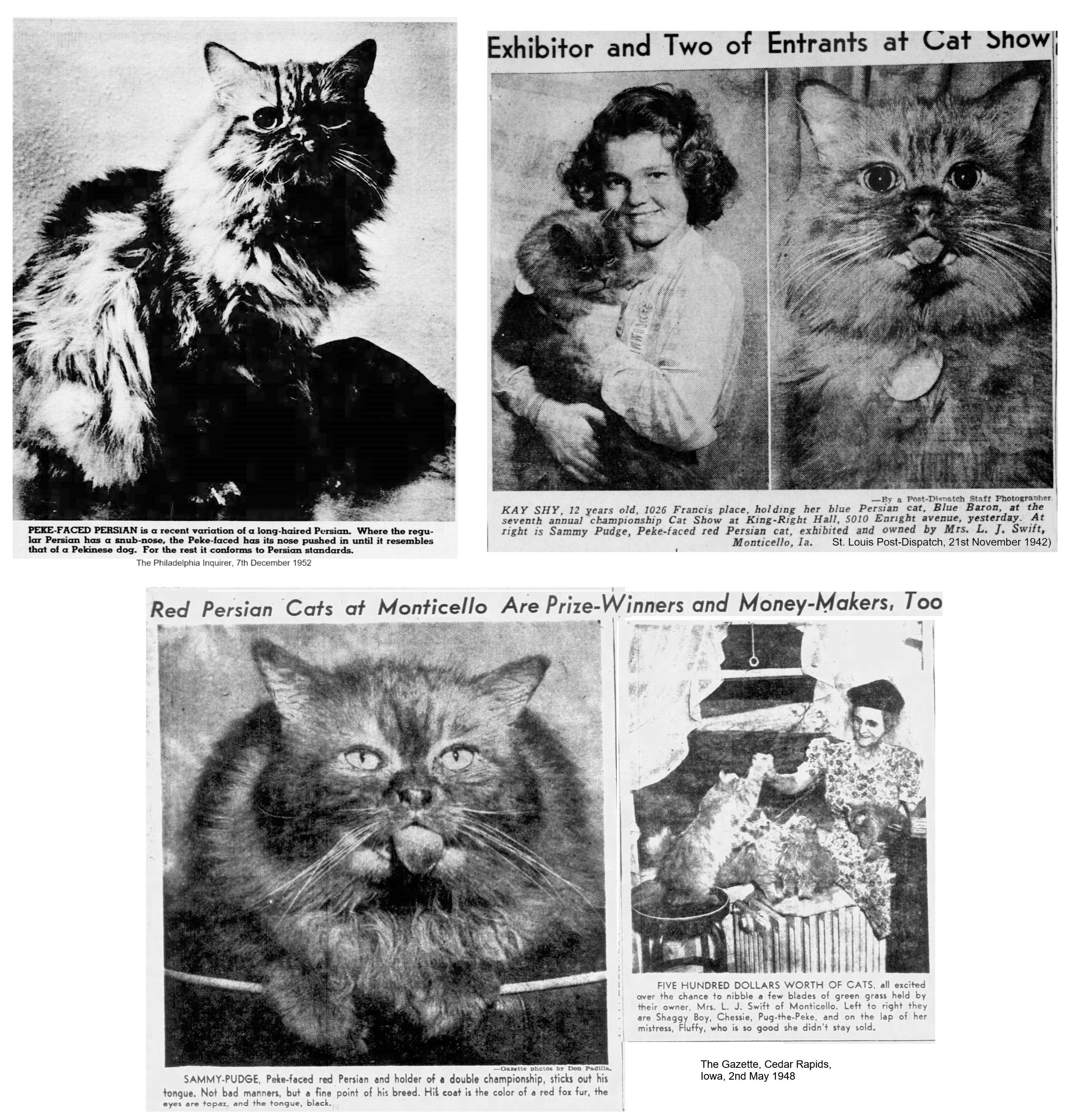
RED PERSIAN CATS AT MONTICELLO ARE PRIZE-WINNERS AND MONEY-MAKERS, TOO by Naomi Doebel. - The Gazette, Cedar Rapids, lowa, 2nd May 1948
MONTICELLO - This is a catty story. Extremely catty, for it concerns the composite nine lives of nine plume-tailed red Persian cats for whom Dr. and Mrs. L. J. Swift of Monticello are finishing the entire second floor of their new brick residence. Extraordinary felines, these. Their actual dollar value on a cat fancier's market amounts to over $1,000, but there are three that the owners would not part with for any price. Not one of these aristocrats responds to the nationally accepted cat-call of - "Here kitty . . . kittv . . . kitty!" They answer to their names. With humans accepted in their social circle they carry on chatty "meows," so varied in tonal quality and spacing that it its evident that they know what they are talking about - especially the impressive "Red Mischief", 8-year-old grand-daddy of them all.
First taken into the Swift home as a pet, the huge cat demands the greatest share of attention and affection yet he dominates the cat household with dignity, yielding to none. not even sweet-tempered Sammy-Pudge, the Peke-faced Persian now waiting to be entered in the big shows in the East. He already holds a double championship, started in the Milwaukee show and finished in St. Louis. Other ribbons taken by Sammy-Pudge and his immediate cat family fill a big desk drawer - ribbons with rosettes, ribbons gold lettered, and a liberal sprinkling of the ribbons that give Mrs. Swift the biggest thrill of all - the Badges of the Feline Fanciers club.
Saucers of milk aren't the dish for these uppity pussy cats . . . sometimes they drink it warm and fresh from the cow, but never the pasteurized or homogenized milk which gives them indigestion. Primarily they are meat eaters . . . not mice or birds, but horsemeat consumed at the rate of 100 pounds a month, which isn't money out of the pockets of Dr. and Mrs. Swift. The red Persians pay their own way. Mrs. Swift has received as high as $465 in a single year from sale of kittens, which have an excellent market at $25 to $75 each. In addition to this, Queen Persians from other communities are sent to Monticello to get a father for their kittens. There's a fee for that, too. But ahead of the pin money is the fun Mrs. Swift has at the feline shows in which her cats are entered and wherein they are prize winners, and the friends she makes through mutual interest in cats. She carries on correspondence with cat fanciers all over the country.
Mrs. Swift used to raise canaries - but cats are more fun. They have the run of the house, with exception of the living room, from which they are barred by fence of the type that keeps little children from tumbling downstairs. Dolly, whose registered name is Wasanda of Eiderdown, has established hospital rights on a box in one of the upstairs closets. She personally selected this closet and for five successive years has had her kittens there. Soon to have another family, she now makes daily visits to the box to make sure that all is in order. Bought from a New York cattery, Dolly is the neatest matron of the lot, always perfectly groomed from the tips of her heavily furred toes ta the last fluffy, hair under her chin. Even the kittens of the red Persians are instinctively clean, according to Mrs. Swift. She doesn't sell them until they are three months old and house-broke - but never has it been necessary to punish a kitten for untidiness. From the time they are big enough to craw! out of the nest they are smart enough to know the pan of sand in the room has been placed there for one purpose ...and they use it.
Each cat has its own unmistakable personality. Fluffy, the one-year-old, probably has the most promising future. Sold at the Milwaukee show for $100, she had such fine points that the judge advised Mrs. Swift to keep her for breeding to build up the quality of the cattery. And the buyer who had bargained for Fluffy gallantly released [from sales contract] the owner of the 'then "best red female" in the show.
Mrs Florence Kemmer, Bradenton, has returned from the St. Petersburg Cat Show where her Silver Moth's Charridette, a solid red peke-faced Persian, completed her undefeated triple championship. Charridette, according to her owner, is the only triple champion in the south, having won her crown in the A.C.A., C.F.A., and C.F.F. Cat associations and is undefeated in all three. Only two years old, Charridette has won at Brooklyn, Long Island, Garden State, Newark, N.J., New Haven, Conn., Empire and Atlantic at New York |City, and both shows at Boston, as well as at New Orleans, Miami and St. Petersburg. Two other Pekes, Silver Moth's Hesahoney and Goldielocks, completed their C.F.A. championships at Norfolk, Va., Philadelphia and Newark, receiving points towards their C.F.F. championship. (Bradenton Cat Completes her Triple Crown. The Bradenton Herald, 21st January 1949)
Another exhibit featured Siamese and Persian cats, shown by Florence Kemmer, who has more than 40 registered cats. Her Peke-faced Red Persian is the only triple undefeated champion of the south. Its name is Charridette. (1500 Attend Tourists' Club Hobby Show in Bradenton. Tampa Morning Tribune, 18th February 1949)
Mr. Yeates is on safer ground when he condemns the rebel breeders who are developing peke-faced cats - dog-like creatures with pushed-in noses and watery eyes. (LONDON. - Britain's King of Cats has abdicated. - Saturday Evening Express, Launceston, Tasmania, 9th July 1949)
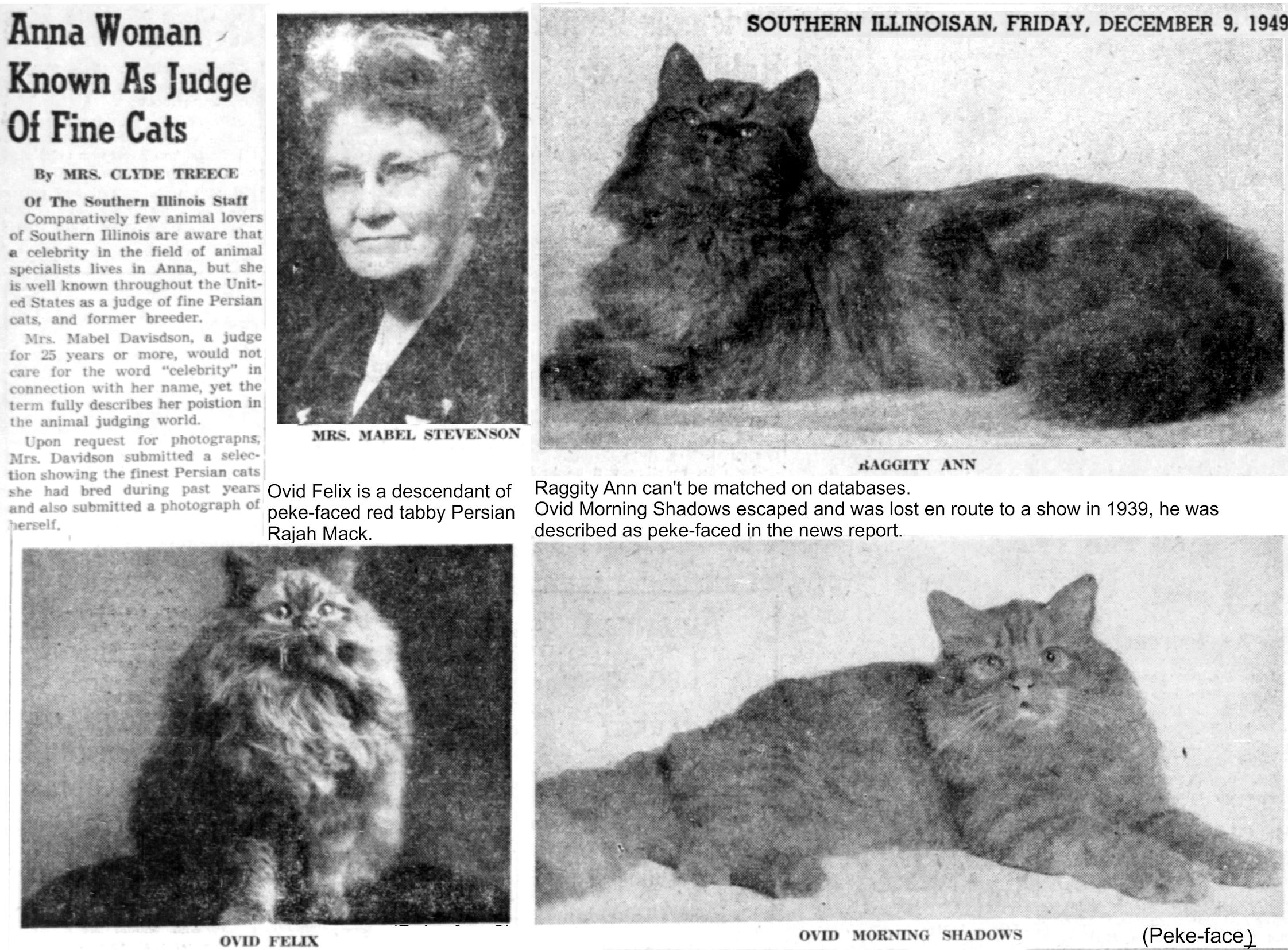
Red Peke-faced female - Elco's Pretty Pekey, Mrs. Ella and Mamie Conroy, New Richmond, O.
Red tabby Peke-faced novice - Elco's Honey Bug, Mrs. Ella and Mamie Conroy, New Richmond, O.
Red tabby Peke-faced open - Elco's Viking Cinderella, Mrs. Ella and Mamie Conroy, New Richmond, O.
(Buffalo Cat Show. The Buffalo News, 20th March, 1950)
Best Peke face - Ch. Silver Mathis [Silver Moth's] Hesahoney, male neuter, owner Mrs. Florence B. Potter, St. Petersburg.
Best Peke faced Red Tabby Cat - Lord Plushbottom, male, breeder-owner: Mrs. L.H. Risler, Decatur, Ga.
([St. Petersburg Cat Club Show] Tampa Bay Times, 21st January, 1951)
One of the most unusual looking cats in the show is a Peke faced red tabby male, Williamette Rajah Boy, owned by Mrs. W.R. More of Coeur d'Alene. The red, tiger-striped cat looks more like a Pekingese dog than a cat, with bulging round eyes and the "punched-in" nose. ([Inland Empire Cat Club Show] Spokane Chronicle, 1st November, 1952)
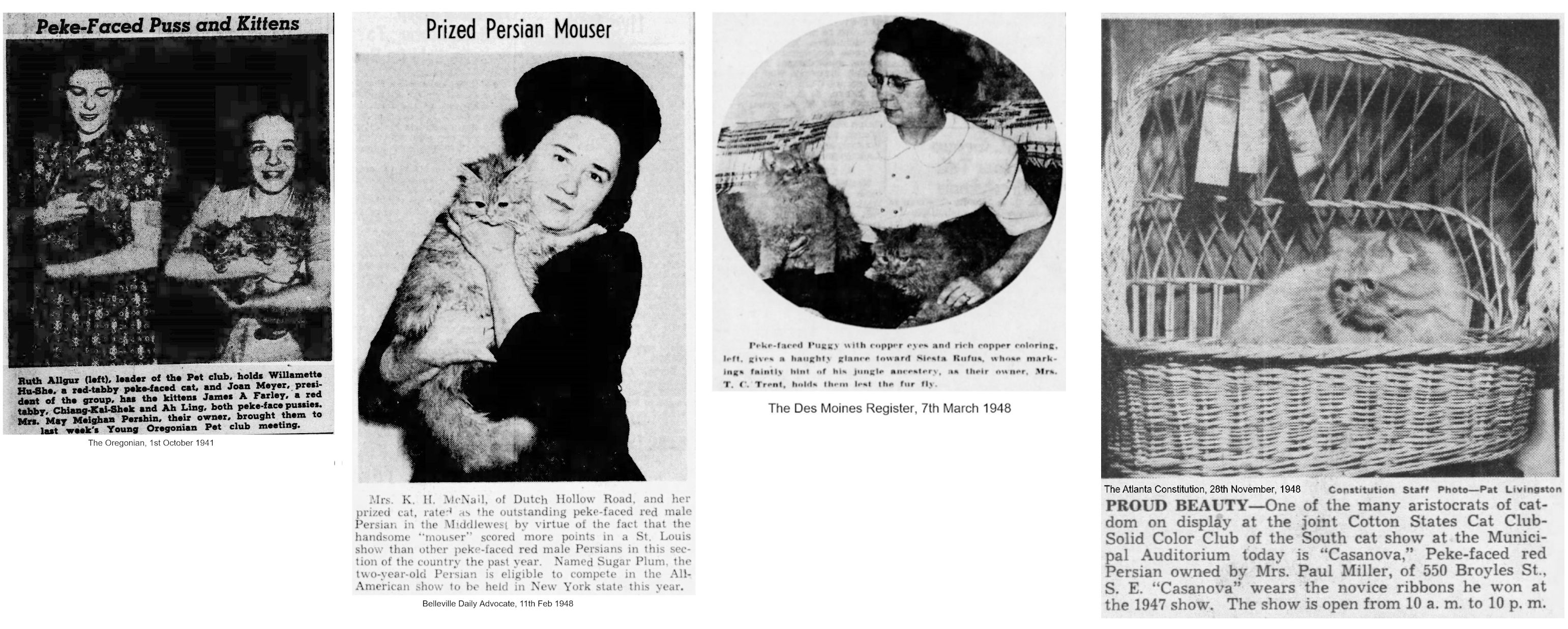
FAR-FIN CATS TO GO TO AKRON. The Far-Fin cats owned by John K. Farris, of Maysville, and Neville Fincel, of Morehead, will be taken to Akron, O., this week end to be entered in the American Cat Association show - sponsored by the Cuyahoga Valley Cat Club. Far-Fin cats being entered in the show include triple champion Elco's Rudolpho, a peke faced red tabby male; triple champion Violetta, a peke faced red female tabby; Madeline, peke faced red female tabby novice; Camille; orange-eyed white female novice Akanta's Mr. Quarternote, black manx, open; and Rene, peke faced cream male novice belonging to the Wells brothers of Lexington. The show is being held Saturday and Sunday in the Portage hotel in Akron. (The Daily Independent, Maysville, Kentucky, 22nd January 1954)
[Genesee Cat Fanciers Club Show] Best all-breed peke-faced red tabby: Elco's Red Banjo of White Cloud (Joyce Ruth Smith) (Cats Compete for Laurels. Democrat and Chronicle, Rochester, NY, 17th October 1954)
Maysville's champion cats came back to town undefeated yesterday with their owner, John K. Farris, proudly displaying the box load of premiums won by the FarFin Catteries, Sunday at the Kentlucky Cat Club Show in Louisville. Their co-owner is Neville Fincel, of Morehead. . . . Continuing undisputed champions are Rudolpho, best male Pekingese red faced tabby who has been rated all American cat . . . At the Louisville exhibits Rudolpho got six in one show and two in another . . . Kruschina, a Peke-faced red tabby female kitten, was rated the best kitten in the show and Don Jose, a red tabbv male kitten was voted the best male kitten. All of FarFin's cats got a major win except Marceline, a peke-faced red tabby female, who received points to finish her championship. Violetta took the peke-faced red tabby female championship. (Far-Fin Cats Win Top Prizes At State Show, The Daily Independent, Maysville, Kentucky, 30th November 1954)
Mrs. Lorraine Wiesemann . . . owns Grand Champion All-American Peke-face red tabby, Rustnik Johnnie . . . Mrs. Wiesemann's cats are named for streets, veterinarians, and college professors. Johnnie is named for Dr. John Farris, music professor at Morehead State College, from whom she bought her first peke-faced tabby. (Cat Judge's Family Pet Is Everything He Shouldn't Be, The Courier-Journal, Louisville, Kentucky. 20th November, 1958)

Peke Faced Tabby Persian Royal Julitta, Mrs. Anna Chervenak, winners [Michigan and American national all-breed shows at Dearborn], plus other color awards. (The Cleveland Press, Ohio, 8th October, 1960)
Mrs. Scott, who has been in the cat business more than 12 years, raises light blue Peke-faced type Persians. Mrs. Jeanette Miller of Kansas City, who is 82 years old . . . has raised Peke-faced Red Tabbies for 40 years. (About Town. The Kansas City Times, 11th September, 1963)
The National Cat Fanciers Association, Inc. re-elected Alvin C. Clark, Eminence, as president for another three year term recently. Mr. Clark is one of the nation's outstanding breeders of purebred Persian cats, specializing in standard and Peke-faced tabbies. (Henry County Local, New Castle, Kentucky, 16th April, 1964)
The long-haired red Persians and red tabbys are very lovely. And "unusual" is the word to describe the Persian peke-faced red and red tabbys. They greatly resemble a Pekingese dog and have a short pug nose, and indentation where the nose meets the forehead, a wrinkle from the eye to the outside corner of the mouth, curved forehead, and eyes that appear to "bug out." There are not very many of these cats, and only the red and red tabby are recognized for show in this country. They are discussed in "Persian Cats and Other Longhairs" by Jeanne Ramsdale. It should appear on pet shop book shelves very soon. (Independent Press-Telegram, Long Beach, California, 19th April, 1964)
In 1964, the national awards list included the following peke-faced Persians from the Cleveland, Ohio area:
Ch. Asgard Julitta, peke-face red tabby Persian female, owned by Mrs. Anna Chervenak of North Royalton, was All-Midwestern honorable mention.
Ch. Rustnik Rollo of Asgard, peke-face red tabby Persian male owned by Mrs Chervenak, All-Midwestern.
Ch. Asgard Anetrah, peke-face red tabby Persian, owned by Mrs. Chervenak, was Royal Inter-American.
Within the past 10 or 15 years, show Persians have become increasingly peke-faced with the pushed-in nose and wrinkled muzzle of the Pekinese dog. (The San Francisco Examiner, 12th September, 1965)
Note: As the showbench Persian became more and more short-muzzled (extreme- or ultra-typed), the term "Peke-faced" started to be applied to all extreme Persians and not to a separate type of Persian. The true Peke-faced variety was only found in the red and red tabby varieties.
Helen Aldrich . . . has received highest honors for her show cats . . . Elco's Sunny Jim of Catty Campus is now all-American Peke-faced red tabby longhair male. (Seaside Signal, Seaside, Oregon, 25th July, 1968)
A few years ago there was a trend toward Peke-faced Persians with the pushed-in nose and wrinkled muzzle of the Pekingese dog. But most Peke-faced now are reds and red tabbies. (Persian Cats are Staging Comeback, Gazette-Telegraph, Colorado Springs , 27th August, 1970)
The Peke-faced Persian, too, has breathing problems, eye trouble, often occlusion, a lot of undesirable results from breeding to show standards. The forehead, nose and chin must be in a short, straight line. An extreme nose break and very wide head are the standards to be met in the hear alone in this breed. The body structure must be heavy on short legs. (Cats and Their Care, The St. Catharines Standard, 31st October, 1970)
The reds and red tabbies in the Persian cat frequently produce in their litters the Peke-faced Persian. This is exactly what the name implies. They look like miniature Pekinese dogs. (Cats and Their Care, The St. Catharines Standard, 25th March, 1972)
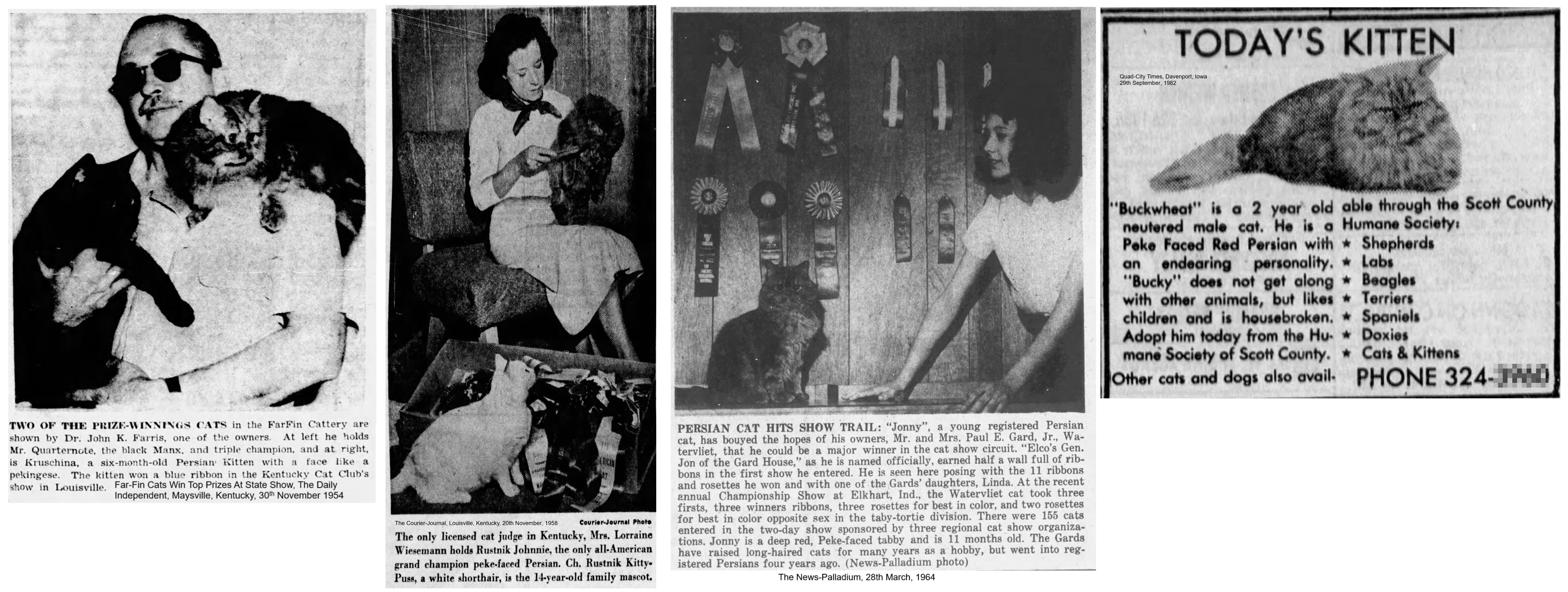
PERSIAN CAT COPIES FLAT DOG by Eleanor Price. The Peke-faced Persian, a rare cat whose face resembles a Pekingese dog's should be red in color, solid or tabby, although other colors have appeared. The union of two Pekes does not guarantee that the kittens will have the short nose with a slight indentation where nose meets forehead, with wrinkles from inside corners of the eye to outside corners of the mouth. Nor does it guarantee "pop" eyes and outward curving forehead. All kittens may be normal Persians, or some may be partial Pekes, perhaps with undesirable results such as jaw deformity. Pekes have their own personalities, are jealous cats, often one-person cats. They may eat and try to drink with their paws. They are agile, with unusual strength in the hind legs. Babies have a high mortality rate, require more careful attention at least to age six months. The Fresno Bee, 30th April 1972)
(The reason they tried to eat and drink with their paws was their flat face made it difficult to eat or drink normally.)
PETS by Eleanor Price. There is a rare cat whose face resembles that of a Pekingese dog, so it seemed only proper he should be called Peke-faced Persian. The short pug nose has a slight indentation where it meets the forehead, and a wrinkle runs from inside the corner of his eye to the outside corner of his mouth. Forehead curves outward somewhat and eyes are prominent. Coat color is usually red, either solid or tabby, although a number of other colors, such as cream, can appear. The true Peke usually remains in the kitten stage longer than a regular Persian and may nurse until five months of age. He develops his own personality, may be jealous, and prefers being a one-person cat. He may eat, and even try drinking, with his paws. There is unusual strength in the Peke's hind legs, which he uses to fight with, as would a rabbit. The union of two Pekes does not guarantee that the kittens will have the rare face. They may be normal Persians or partial Pekes, perhaps with faults such as teeth misalignment. The teeth should meet evenly. (The Los Angeles Times, 16th Sept 1973)
The most aristocratic cat of all, say [Ernest and Dorothy Otten, Morningside Cattery], would be "a real good blue, what we used to call peke-faced Persians." (Match Puss 'n' Personality. The Atlanta Journal, 15th March, 1978)
Longhair cats are the result of crossbreeding Persian and Angora cats. Few pure Persians still exist and both are grouped as one breed. Also in the same group and not a separate breed is the Peke-faced cat that has a flattened pug nose and wrinkled face. (How Many Breeds of Cat Are There? The Salt Lake Tribune, 10th December, 1979, and various others)
During the mid 1970s and early 1980s, breeders and fanciers preferred the brachycephalic head shape and "piggy expression" in all Persians. Selective breeding - including crossing peke-faced reds to solid colour Persians - meant noses moved up between the eyes and faces were flattened. Although often called peke-faced, these were not the same as the peke-faced cats of the 1920s -1960s. By the 1990s the true Peke-faced Red/Red Tabby Persian was almost extinct.

According to by Judy & Greg Brocato in The Cat Fanciers' Almanac, 1995, "The peke-faced solid red Persians would surely be first on the endangered species list, if CFA had such a list. One must be reminded to include the color class 0112 and 0113 in the Solid Division. Peke-face solid reds are not seen in exhibition today. Few of the judges polled can remember handling a solid peke-face. CFA reports only one (a male) registered in 1993 and a total of only 98 registered since 1958." Considering the breathing, eating, tear drainage and birthing problems, and the increasingly extreme-typing of showbench Persians, the decline of peke-faced red/red tabby Persians isn't surprising. Breeders had noted that peke-faced cats had difficulty breathing and the kittens had difficulty suckling.
The Brocatos went on to describe the skull conformation: "Peke-faced reds should conform in color and general type to the standard for reds; however, allowances should be made for the slightly higher ears. The underlying bone structure of the head differs greatly from the standard Persian. The nose should be depressed and indented between the eyes. The muzzle should be wrinkled. There should be a horizontal break located between the usual nose break and the top dome of the head. This second break creates half-moon boning above the eyes and an additional horizontal indentation in the center of the forehead."
Finally they noted "Over the years the term peke-face has been inaccurately applied to many Persian exhibiting extreme head type. A true peke-face must possess the markedly different skull structure described in the standard. A peke-face red can appear in litters of normal reds. Mating a peke-face to another peke-face does not ensure that there will be pekes in the resultant litter." Some time after they wrote the description, the breed went from "endangered" to "extinct," but at the same time, the Persian breed became increasingly flat-faced.
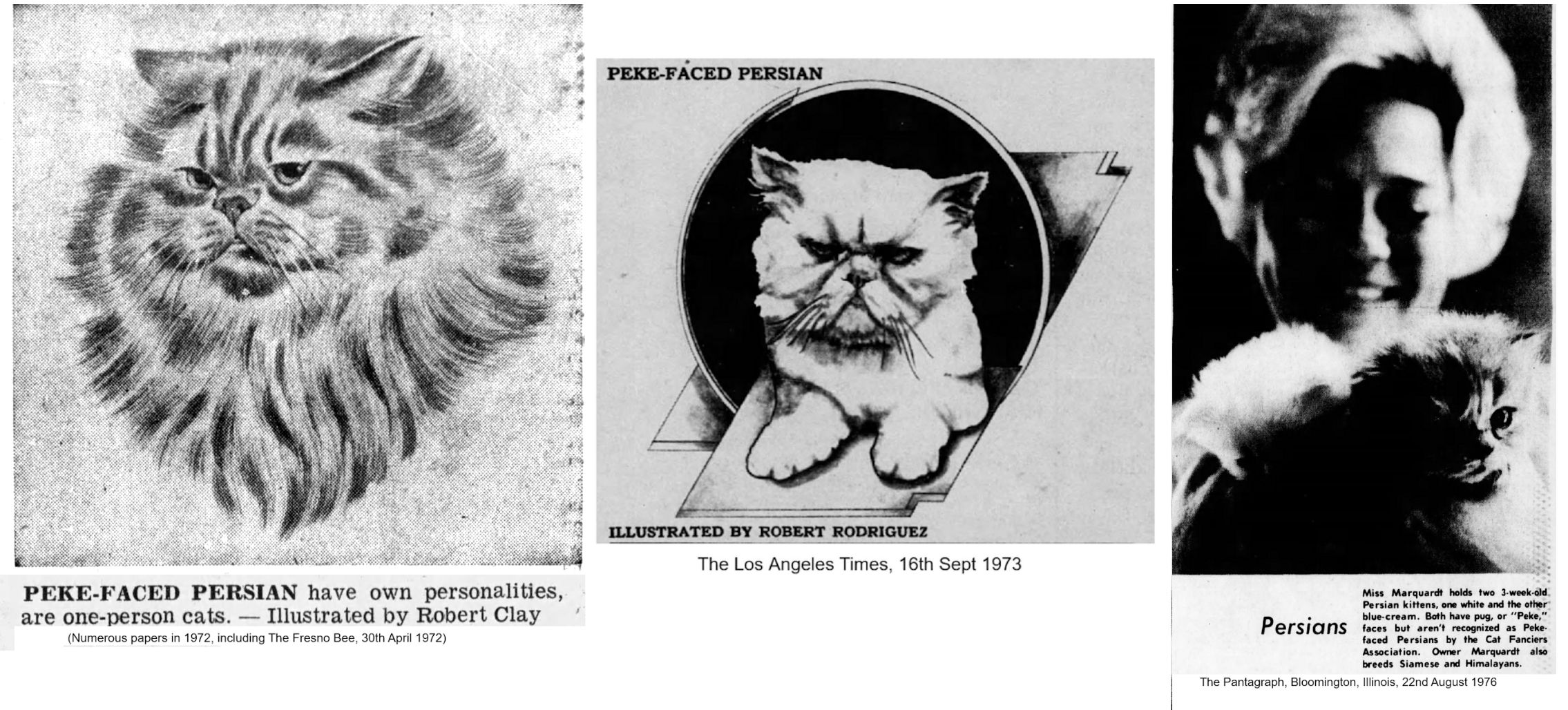
The true Peke Face Persian became so extreme that there were problems with the eyes because the orbital bone was not keeping the eyes secure. One of my correspondents was at a show where the judge took the cat from the cage and set it on the table. As she lowered it onto a standing position, the eyes rolled forward in the head and bulged outwards. The judge picked the cat back up so that the front feet were higher than the back and the eyes rolled back into place. She then she called for the owner. This, along with suckling problems in kittens led to a move away from such extreme faces with bulging eyes, but the extremely short nose remains a feature of modern Persians.
These genealogies are large and should be opened in a new window or downloaded and viewed using a photo viewer program.
Rajah Mack (1912), Viking, Far-Fin and early Elco's lines
Viking lines, 1930s - 1960s
Rustnik, Demigod and Wenlock lines.
Elco's lines, part 1.
Elco's lines, part 2.
Silver Moth lines.
Smithway lines, part 1.
Smithway lines, part 2.
Smithway and Aristocat lines.
Smithway and Lee-Nora lines.
Sunkist lines.
Smithway and McCoy lines.
Callavorn, Pineland and Mil-War lines.
Jay-Kay lines.
Pekeowl, Just-A-Mere and Eiderdown lines.
High Hopes line.
Andelrac line.
Miscellaneous Elco's side-branches.
Miscellaneous branches (do not fit on main charts)
Dead ends and peke-face cats from non-peke-face lines